
Senior Instructor, Department of Computer & Information Science (DCIS)

|
Vat Kam Hou 屈鑑濠 Senior Instructor, Department of Computer & Information Science (DCIS) |
10 Principles of Effective Online Teaching: Best Practices in Distance Education
|
Teaching online for the first time is a little like trying to drive a car in a foreign country. You know how to drive, just like you know how to teach, but it sure is hard to get the hang of driving on the left side of the road … you’re not quite sure how far a kilometer is … and darn it if those road signs aren’t all in Japanese.If you’d like to better understand the “rules of the road” for online teaching and learning, 10 Principles of Effective Online Teaching: Best Practices in Distance Education is the perfect guidebook.In the traditional college classroom today, faculty and students arrive with a set of expectations, shaped largely by past experiences. And although students may need the occasional (or perhaps frequent) reminder of what’s required of them, there’s usually something very familiar about the experience for both faculty and students alike. In the online classroom, an entirely new set of variables enters the equation. Variables that, if not managed properly, can lead to frustration and an overall bad experience for teacher and learner. |
This special report features a series of columns by Dr. Lawrence C. Ragan, Director of Instructional Design and Development for Penn State’s World Campus, and will help you establish online instructor best practices and performance expectations. The following snippets are just a taste of the insider’s advice found in the full report: Principles of Effective Online Teaching: #1 Show Up and Teach — The necessity of this statement is borne of the misimpression that the online class “teaches itself.” Since most of the course is already authored and designed for online delivery, instructors may believe they simply need to serve as the proverbial “guide on the side” as the students navigate the learning system. Not true! Principles of Effective Online Teaching: #2 Practice Proactive Course Management Strategies — The online instructor can help create a successful learning experience by practicing proactive course management strategies such as monitoring assignment submissions, and communicating and reminding students of missed and/or upcoming deadlines. Principles of Effective Online Teaching: #3 Establish Patterns of Course Activities — Although the online classroom environment provides tremendous flexibility of time and place of study, establishing and communicating a course pace and pattern of work can aid both instructor and student, and alleviate confusion around how the course operates. Principles of Effective Online Teaching: #4 Plan for the Unplanned — For those small or not-so-small occasions when “life happens,” having a strategy for informing students of these changes can go a long way to maintaining course continuity. Principles of Effective Online Teaching: #5 Response Requested and Expected — Timely instructor feedback is essential for the online learner to manage their learning experience. Instructors are expected to respond to student inquiries within one business day. Principles of Effective Online Teaching: #6 Think Before You Write — Most experienced online instructors can relay a variety of stories about a dialogue with a student that went awry due to a misinterpretation or misunderstanding of the intended message. Take special care to be as clear and concise as possible. Principles of Effective Online Teaching: #7 Help Maintain Forward Progress — Students in the online classroom rely on the timely return of assignment and exam grades in order to maintain positive forward progress in their studies. Principles of Effective Online Teaching: #8 Safe and Secure — Using the institutionally supported learning management system provides increased degrees of security and confidentiality and keeps “institutional business” within the appropriate confines. Principles of Effective Online Teaching: #9 Quality Counts — Instructors need to establish strategies for addressing the quality of the online learning experience, including content resources, instructional design strategies, and systems performance. Principles of Effective Online Teaching: #10 (Double) Click a Mile on My Connection — As with many aspects of the online classroom, the technological infrastructure plays a critical role in determining student and instructor satisfaction. 10 Principles of Effective Online Teaching: Best Practices in Distance Education will serve as a valuable guidebook for new online educators, or those who are looking for proven strategies to help them overcome the unique challenges of online teaching. |
11 Strategies for Managing Your Online Courses |
Much has been written about the challenges of teaching an online course. While not discounting the unique (and sometimes frustrating) aspects of the online learning environment, it could be said that, despite the numerous differences, many of the same course management strategies that are essential to success in a traditional classroom also apply in the online classroom.A strong syllabus, clear directions, well-organized materials, and timely feedback are the building blocks of any course management plan … whether you teach online or face to face. Of course, the big challenge for online instructors is that the very nature of online education amplifies the importance of properly addressing these management issues, while throwing a few more additional obstacles into the mix. So if you think the flexibility of online teaching also means that it’s OK to “wing it” now and then, you’d be wrong. If anything, you have to be more organized, more consistent and more prepared for anything than ever before. Choosing the right communication tools and protocols, addressing technology problems, managing student expectations, and building community are just some of issues that can stretch online instructors to the breaking point. |
11 Strategies for Managing Your Online Courses was created to help online instructors tackle many of the course management issues that can erode the efficiency and effectiveness of an online course. It features 11 articles pulled from the pages of Online Classroom, including:
Remember, you’re not the only one who may be a little anxious about going online. Students often have anxiety when taking their first online course as well. It’s up to you to help them feel more confident and secure, all the while keeping your workload at a manageable level. The course management tips in this report will help. |
Assessing Online Learning: Strategies, Challenges and Opportunities |
As online education moves into the mainstream of the higher education ecosystem, one question still persists: “How do I know what my online students have learned?” There are no easy answers, just as there aren’t in face-to-face courses, but with a little creativity and flexibility, you soon discover that the online learning environment opens up a host of new educational assessment possibilities.Of course, just as with traditional courses, the trick to online assessment is finding the right combination that works best for your particular course. This special report Assessing Online Learning: Strategies, Challenges and Opportunities will show you how. |
This special report features 12 articles from Online Classroom that will cause you to examine your current methods of online assessment, and perhaps add something new to your assessment toolbox. It even talks about some of the common assessment mistakes you’ll want to avoid. Take a look at some of the articles will find in Assessing Online Learning: Strategies, Challenges and Opportunities:
In addition to illustrating how well students meet the expected learning outcomes, well-planned assessment can provide valuable insights for course and program improvement, and can serve as a bargaining tool for resource allocation and compensation negotiation. Online courses enable a strong student-centered approach to learning and, as a result, assessment. We hope this report helps you design and develop online assessment strategies that take full advantage of the many formal and informal assessment tools now at your fingertips. Assessing Online Learning: Strategies, Challenges and Opportunities features a variety of assessment methods, some that have been adapted from proven on-campus practices and some that are have been created specifically for the online classroom. If you want insight into how to assess online learning at the course, program, and institutional levels, you’ll want to download Assessing Online Learning: Strategies, Challenges and Opportunities a new special report that will help you create more effective online assessment exercises and strategies. |
Best Practices for Training and Retaining Online Adjunct Faculty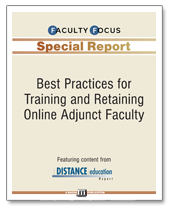
|
As colleges and universities continue to expand their online course offerings, increasingly they’re turning to adjuncts to help carry the load. These online instructors, many of whom work full-time in addition to their part-time teaching gig or teach online courses at multiple schools, create unique training and retention challenges. This report features strategies for ensuring distance education faculty have the necessary training and support to succeed.Higher education institutions invest significant time and resources in the recruitment and hiring of online instructors. To lose them because they don’t receive adequate training, compensation or support would be a waste of time, effort, and resources, not to mention the potential impact on course quality. |
his Faculty Focus special report contains 12 articles pulled from the pages of Distance Education Report. The articles feature best practices from colleges and universities who have solved the training and retention puzzle and come up with innovative approaches to ensure their online instructors are trained on the technology and techniques, feel connected to the institution and other educators, and are supported throughout their entire teaching experience.
Take a look at the articles you will find in Best Practices for Training and Retaining Online Adjunct Faculty:
Online educators report that lack of contact with colleagues and the institution can lead to isolation and frustration. Without the proper training and support system, they may stop teaching online or fail to achieve their full potential as educators. For institutions, failure to build a sense of community for online faculty, including a virtual faculty lounge where they can go to for ideas, support and encouragement, is an expensive mistake they can’t afford to make over and over again. Best Practices for Training and Retaining Online Adjunct Faculty will provide you with the practical strategies that will make a big difference when it comes to training, supporting and retaining your online faculty. |
Designing Online Courses: Models for Improvement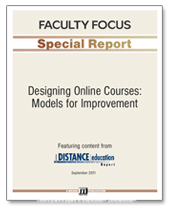
|
Designing an online course shares many of the same elements and processes that go into designing a traditional face-to-face course, however the online environment brings a unique set of challenges that require special attention and a different approach.Faculty charged with developing their own online courses can find learning the new technology particularly frustrating, and those who are not early adopters to technology might resist the process entirely. Many institutions are realizing that the development and delivery of online courses is an increasingly complicated process, requiring both a specialized pedagogy and a technological expertise – and it’s rare to find both qualifications in the same person. In the article “The Collaborative Approach to Developing Online Courses,” the author explains how one university adopted a centralized and standardized approach to the design, development, and management of online programs that respects the talents of both instructional designers and faculty by allowing each to work in their own specialty. As a result, courses have the same quality standards and a more consistent look and feel. |
This 20-page special report features eight articles pulled from the pages of Distance Education Report, and covers a variety of different aspects of online course design. Take a look at the articles you will find in the report:
Whether you’re developing a new online course from scratch, or updating one that’s starting to show its age, this report will give you new ideas to consider. |
Distance Learning Administration and Policy: Strategies for Achieving Excellence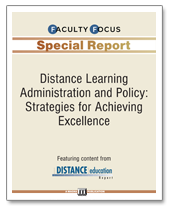
|
When building an online program, there is a seemingly endless list of big questions that need to be answered. Among them are: What kind of program you want it to be – high tech or low tech? Professor intensive or adjunct driven? Blended learning or fully online? What kind of technology will be used to deliver course content? What about opportunities for collaboration?If you’re looking for proven strategies from distance education leaders who know what works, and what doesn’t, when it comes to distance education, you’ll want to download this FREE special report: Distance Learning Administration and Policy: Strategies for Achieving Excellence. Although distance learning is no longer in its infancy, there are still a lot of unknowns. It’s easy to get overwhelmed by the questions and the possibilities of what you want your online program to look like today … not to mention five years from now. Here’s your chance to take some of the best practices learned by those who blazed the trail before you. We created this special report to provide some solutions to the big questions about distance education: About pedagogy, technology, philosophy and administration of distance learning programs. In this report, you will find concise, informative articles on distance education administration and policy that have appeared in Distance Education Report. |
Here are just some of the articles you will find in Distance Learning Administration and Policy: Strategies for Achieving Excellence:
|
Faculty Development in Distance Education: Issues, Trends and Tips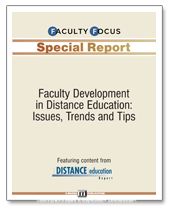
|
Of the many lessons learned from the early years of distance education one of the most persistent to remain, and thankfully so, is the fact that you cannot simply pluck an instructor out of the classroom, plug him into an online course, and expect him to be effective in this new and challenging medium. Some learned this lesson the hard way, while others took a proactive approach to faculty training from the start.Here’s your chance to learn from the mistakes and successes of those who blazed the distance education trail. Faculty development for distance educators is a critical component of all successful distance education programs. Well thought-out faculty development weaves together needed training, available resources, and ongoing support, and carries with it the same expectations for quality teaching that institutions of higher education have for their face-to-face classes. |
This special report, Faculty Development in Distance Education: Issues, Trends and Tips, features 12 articles pulled from the pages of Distance Education Report, including:
This report is loaded with practical strategies that can help you build a comprehensive faculty development program, helping ensure that instructors stay current in both online pedagogy and practical technical know-how. |
Online Course Design: 13 Strategies for Teaching in a Web-based Distance Learning Environment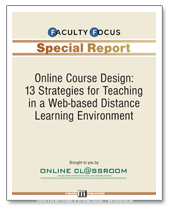
|
After years of teaching face to face, many instructors are able to begin teaching a traditional, classroom-based course without having the entire course laid out ahead of time. This approach doesn’t work very well in the online classroom where careful planning and course design is crucial to the success of online students.Good online course design begins with a clear understanding of specific learning outcomes and ways to engage students, while creating activities that allow students to take some control of their learning. It also requires a little extra effort upfront to minimize two of the most common frustrations of online learning: When learners can’t find what they need or are confused about where to go and what to do, it is harder for them to learn. Being an online learner is challenging enough without these additional barriers. Plus, frustrated learners tend to either drop out or drive the instructor crazy – neither of which is an outcome we want. If you’re looking for best practices in developing online courses, you’ll want to download this FREE special report Online Course Design: 13 Strategies for Teaching in a Web-based Distance Learning Environment. |
Online Course Design: 13 Strategies for Teaching in a Web-based Distance Learning Environment is a great resource for anyone who’s involved in online learning revolution. Just look at the insightful articles featured in the report:
Whether you’re an experienced online educator or course designer looking for fresh ideas, or someone who’s just getting started with online classes, this free special report gives you proven strategies that you can use right away. |
Online Course Quality Assurance: Using Evaluations and Surveys to Improve Online Teaching and Learning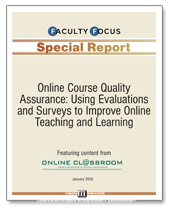
|
In today’s competitive online learning landscape, students have more options and higher expectations than ever before. Ensuring quality is not just important, it’s critical … and it requires constant vigilance. Simply having an online program is no longer good enough, if it ever was. So what are you doing to ensure the quality of online courses and programs at your institution?Creating surveys is easy, but creating good surveys take more thought and effort. This special report will show you how to build surveys that ask the right questions, the right way, to get the information you need. In the report you will find 10 articles from Online Classroom, including a three-part and a five-part series that provides step-by-step guidance on how to use surveys and evaluations to improve online courses, programs, and instruction. You’ll learn when to use surveys, how to design effective survey questions, why it’s important to ensure anonymity, and the advantages and disadvantages of Web-based surveys.
|
Articles in Online Course Quality Assurance: Using Evaluations and Surveys to Improve Online Teaching and Learning include:
In order to improve online programs, courses, and instruction, you have to first determine your goals, select metrics that will tell you what we want to know, analyze these metrics for clues about needed changes, and then make those changes. It may sound simple, but it isn’t. If you’re dedicated to continuous improvement, this special report is loaded with practical advice that will help you create more effective surveys before, during, and after your course ends. |
Online Student Engagement Tools and Strategies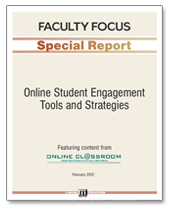
|
Most online students, even those who are successful, will tell you it takes an extra dose of motivation to stay on top of their assignments compared to the traditional classroom. No wonder online courses have an attrition rate that’s 10 – 20 percent higher than their face-to-face counterparts.The anytime/anywhere convenience of online learning sometimes makes it too convenient … to procrastinate, forget about, and become otherwise disengaged. For faculty teaching in the online classroom, this reality underscores the importance of having activities that build student engagement and help create a sense of community among their geographically dispersed students. |
Online Student Engagement Tools and Strategies features 11 articles pulled from the pages of Online Classroom newsletter and provides practical advice from online instructors who recognize the value of engagement and its role in student retention and success. Here are just a few of the articles you will find in this 22-page report:
In short, this special report explains how adjustments in tone, technology, teaching presence and organization can bring positive changes to student learning. |
Promoting Academic Integrity in Online Education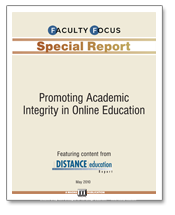
|
Although there’s some disagreement as to whether distance education is more susceptible to academic dishonesty than other forms of instruction, what isn’t up for debate is the fact that for as long as there’s been exams, there’s been cheating on exams. The online environment simply opens up a different set of challenges that aren’t typically seen in traditional face-to-face courses.If you teach online or manage the distance education program for your school, the issue of academic integrity is always top of mind. This free report features nine articles from Distance Education Report that will give you the latest techniques and technologies for mitigating cheating and other unethical behaviors in your online courses. Ask most people who don’t teach online about the likelihood of academic dishonesty in an online class and you will likely hear concerns about the many ways that students could misrepresent themselves online. |
Indeed, concerns about the lack of face-to-face faculty-student interactions have forced online education providers to continuously examine their programs and develop sophisticated approaches to ensure the integrity of their academic programs. As a result, some believe that distance education has done more to align pedagogy, assessments, and learning objectives than many traditional post-secondary programs. You can read about many of them here in Promoting Academic Integrity in Online Education. The 20-page special report features these articles:
|
Strategies for Increasing Online Student Retention and Satisfaction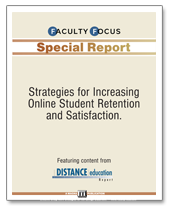
|
Despite the tremendous growth of distance education, retention remains its Achilles’ heel. Estimates of the failed retention rate for distance education undergraduates range from 20 to 50 percent. Distance education administrators believe the failed retention rate for online courses may be 10 to 20 percent higher than for face-to-face courses. Failure to address online course retention will have a significant impact on a program’s bottom line and ability to grow.If you’re looking for smart strategies that will help you stem the tide of online student attrition, you’ll want to download this FREE special report: Strategies for Increasing Online Student Retention and Satisfaction. |
As an increasing number of colleges and universities identify online education as a critical component to their long-term strategy, the issue of retention can no longer be ignored. It is mandatory for everyone who touches the distance learner to understand why these students leave their online courses, and what it will take to keep them there. Featuring a collection of top articles from Distance Education Report, this new Faculty Focus Special Report provides practical strategies for improving online student retention, engagement and satisfaction. Articles include:
If you’re worried about losing your online students, you’ll want to get your hands on Strategies for Increasing Online Student Retention and Satisfaction, a special report developed to give you the strategies you need to keep your students engaged and enrolled. |
Student Collaboration in the Online Classroom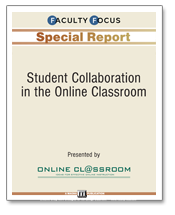
|
How do you bring students together when they’re physically dispersed? Building relationships and communities in online courses is a concern for anyone involved in distance learning. After all, getting students to work effectively in groups is always a challenge. When you add the variables of time and distance to the equation, there are even more obstacles to overcome.If this type of challenge sounds familiar to you, you’ll want to download Student Collaboration in the Online Classroom, a FREE special report developed to share best practices and current thinking on online student collaboration. |
One of the best teaching tools in a traditional classroom is the team project. When students work together, they learn a great deal – not just about what they’re studying, but about how to work with others toward common goals, with shared responsibilities, for shared reward. Traditional classrooms have an innate advantage in bringing students together … the students are sitting there right in front of them. A collaborative project can begin by simply seating the team at the same table. Things are much different in an online environment. Students are not in the same room. They may not be in the same ZIP code. They may not be in the same state, or even country. Not only that, but due to the asynchronous nature of most distance education courses, it’s unlikely the students will even be online at the same time. It’s no surprise, then, that adapting collaborative projects to online classes has been a challenge for educators. This 32-page report, Student Collaboration in the Online Classroom, is yours FREE simply by signing up for Faculty Focus e-newsletters.Student Collaboration in the Online Classroom is a collection of reports and analyses by the editorial staff of Online Classroom newsletter, complemented by submissions from educators at leading colleges and universities nationwide. Nearly 20 articles fill the pages of this special report, examining a wide range of student collaboration-related issues. Here’s just a small sampling:
It’s a detailed look at the state of the art in online collaborative projects, and truly a “must-read” for anyone on the leading edge of online education today. |
Tips for Creating a Distance Learning Program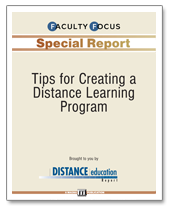
|
Finally, a special report from the front lines that details how distance educators are solving today’s distance learning challenges.How do you overcome the many obstacles of launching a distance education program? And, once you’ve successfully launched your online program, what’s the best way to grow it? Distance education is only now overcoming its status as an academic upstart; some sort of fringe offering that’s inferior to traditional classroom learning. Like any new movement, distance education has its growing pains. But in experiencing these challenges, it’s important for distance educators to know that they’re not alone. Many of these difficulties are actually common experiences, and your colleagues across the country have been working on smart, creative ways to turn them to their advantage. So, where do you find the best distance learning ideas? |
Best practices in distance learning from a source you can trust There’s no shortage of information out there on distance education, but wouldn’t it be great if you had quick access to battle-tested advice from the front lines without having to wade through volumes of extraneous material? Now you do. Developed by the editor of Distance Education Report newsletter, Tips for Creating a Distance Learning Program is a collection of articles by educators who understand the challenges of distance education, and have developed practical solutions and actionable advice that will set your program on the path to success. Best practices include:
Tips for Creating a Distance Learning Program will provide you with the facts on what works to keep your distance learning program moving forward. You’ll find ideas from distance educators who’ve found creative yet practical solutions to the common pitfalls to establishing distance learning programs. Regardless of your distance education experience, you’ll find this new resource worth your time. Get the support you need to drive your distance learning programs forward! In less than an hour, you can discover proven distance learning techniques that you can use immediately. I speak with distance education administrators and educators on a daily basis and I understand you are very busy indeed. So, with such limited time, isn’t it worth it to get a resource that already has the “digging” done for you? That’s why you’ll appreciate this fast-reading report that distills the most essential information on distance learning programs into a useable format that’s easy to digest. I urge you to download your complimentary copy of Tips for Creating a Distance Learning Program, right now. |
Go to: Dr. Vat's FST Homepage | Recommended Items (Page 0 |1 | 2 | 3 | 4 | 5 | 6 | 8 | 9)
Kam Hou Vat, PhD
Faculty of Science and Technology
University of Macau
Av. Padre Tomás Pereira, Taipa,
Macau, China
Room: N327C
Telephone: (Office) (853) 8397-4379, (Mobile) (853) 66501747
Fax: (Office) (853) 28838314 or (Home) (853) 28832731
Email: fstkhv
Personal Homepage: http://www.fst.umac.mo/en/staff/fstkhv.html
Downloadable: CV | Short Profile
Visitor Counter: